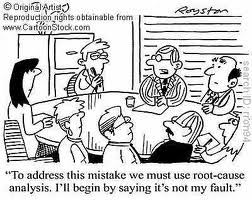 Today I’m going to discuss the concept of root cause. This is the underlying cause of any problem. It is important to understand this because if we fail in our original estimation as to the root cause of a problem then any solution we might decide upon is going to be fundamentally flawed.
Today I’m going to discuss the concept of root cause. This is the underlying cause of any problem. It is important to understand this because if we fail in our original estimation as to the root cause of a problem then any solution we might decide upon is going to be fundamentally flawed.
It is important for another reason as well; in order to get elected, receive a promotion, sell a product, or get ahead there are people out there who will attempt to distract us from the root cause of an issue in order to lay the blame on a tangential target. If we allow our critical thinking skills to fail then we can be fooled in making a poor decision. The more poor decisions we make the worse our life becomes.
The idea of a root cause is simple enough. I would suggest a lengthy perusal of the Wikipedia article linked above but it gives a good short checklist to find if a cause is root or not.
- It is clearly a (or the) major cause of the symptoms.
- It has no worthwhile deeper cause. This allows you to stop asking why at some appropriate point in root cause analysis. Otherwise you may find your-self digging to the other side of the planet.
- It can be resolved. Sometimes it’s useful to emphasize unchangeable root causes in your model for greater understanding and to avoid trying to resolve them without realizing it.
What’s important to understand here is that we face this sort of critical thinking challenge multiple times every day. Every problem that we face needs a critical analysis. It is one of those things we must get into the habit of doing, like going to the gym, eating right, and trying to be patient when helping our aging parents with their computer issues. The more you go through the root cause analysis process the more it will become habit and the better your decisions will become.
Wikipedia again comes to the rescue with this root cause analysis article and, again, I suggest a lengthy perusal but I’ll try to sum it up quickly here.
- Define the problem! I can’t stress this one enough. Often we don’t even know what the problem is in the first place and we’re asking the wrong questions.
- Be systematic. This is crucial because we often have preconceived notions of blame. We often don’t want to blame ourselves because of something called Cognitive Dissonance. I will devote an entire blog to that topic soon. Look at all the possible explanations even the ones you would ordinarily dismiss.
- Be aware that after you find one root cause that you cannot stop. There can be multiple root causes.
- Develop a timeline. This can be extremely helpful in ordering root causes and contributory factors.
So, the idea here is to properly define a problem and its root causes and only then can we go about finding a solution. And that is why we do this. To find a real solution. Not the mumbo-jumbo solutions offered to us by politicians and policy makers. Real solutions to real problems. If you can do this regularly and effectively it will change your life and if we can get an entire nation of people doing it then it will change the world.
And now a simple example: You’ve noticed your clothes don’t fit you anymore.
Likely Causes: I’m eating too much, I have a medical condition, I’m exercising less, my clothes are shrinking.
Analysis: Count your calories and compare them to charts for someone of our size and age. Count the number of hours your exercise. Visit a doctor. Go to the store and try on some new clothes of the same size as the old.
You get the point. It’s important to do this because maybe it was a medical condition and you just saved your life. Try this approach to one problem a day and if that works, try two a day after a while. Get in the habit!
As always, Like, Tweet, Comment, Stumble, and otherwise tell your friends if you think this might be of interest to them.
Tom Liberman
Sword and Sorcery fantasy with a Libertarian Twist
p.s. A loyal viewer sent me a link to an excellent website, Transparency International, in regards to my post on Crony Capitalism. Check it out.

Pingback: Nuclear Power – from a Critical Point of View « tomliberman
Pingback: Idealism and its Dangers « tomliberman